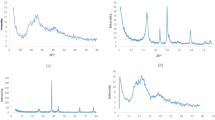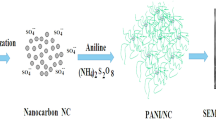Abstract
The incorporation of different materials can improve the properties of conductive polymers to become composites. This paper studies the morphological, structural, optical, and electrical effects of adding different weight ratios of silver nanoparticles (Ag NPs)-carbon (C) mixture into poly(9,9-di-n-octylfluorenyl-2,7-diyl) (PFO) polymer by a low-cost and straightforward method. The thin films are prepared by drop-casting the prepared composite onto silicon substrates. Transmission electron microscopy shows Ag NPs embedded into the carbon. Field emission scanning electron microscopy images show increased Ag NPs-carbon particle size in PFO. The weight ratio increases due to aggregation, consistent with decreasing band gap trend from the Tauc plot. Ultraviolet–visible (UV–Vis) spectroscopy shows a redshift pattern of the central peak of PFO as the weight ratio increases. Photoluminescence and Raman spectra show that Ag NPs-carbon mixture increases β-phase percentage in PFO due to poor solvent effect. Lastly, the 10% Ag NPs-carbon-PFO sample exhibits the highest electrical conductivity among the three samples studied. A proposed schematic diagram shows how Ag NPs-C particles influence the morphology of the PFO chain and electrical properties of PFO-Ag NPs-C composite.













Similar content being viewed by others
Data availability
Not applicable.
References
Irimia-Vladu M et al (2010) Biocompatible and biodegradable materials for organic field-effect transistors. Adv Func Mater 20(23):4069–4076
Bajpai M, Srivastava R, Kamalasanan MN, Tiwari RS, Chand S (2010) Charge transport and microstructure in PFO:MEH-PPV polymer blend thin films. Synth Met 160(15–16):1740–1744
Liang J et al (2016) Improving efficiency and color purity of poly(9,9-dioctylfluorene) through addition of a high boiling-point solvent of 1-chloronaphthalene. Nanotechnology 27(28):284001
Jumali MHH, Al-Asbahi BA, Yap CC, Salleh MM, Al-Salhi MS (2012) Optoelectronic property enhancement of conjugated polymer in poly(9,9′-di-n-octylfluorenyl-2.7-diyl)/titania nanocomposites. Thin Solid Films 524:257–262
Brenner P, Fleig LM, Liu X, Welle A, Brse S, Lemmer U (2015) Degradation mechanisms of polyfluorene-based organic semiconductor lasers under ambient and oxygen-free conditions. J Polym Sci Part B: Polym Phys 53(15):1029–1034. https://doi.org/10.1002/polb.23733
Pourhashem S et al (2020) Polymer/Inorganic nanocomposite coatings with superior corrosion protection performance: a review. J Ind Eng Chem 88:29–57
Khan A et al (2018) Polymer–inorganic nanocomposite and biosensors. In: Khan A, Jawaid M, Khan AAP, Asiri AM (eds) Electrically conductive polymer and polymer composites. Wiley, New Jersey, p 247
Dutta K (2017) Polymer-inorganic nanocomposites for polymer electrolyte membrane fuel cells. In: Yang Y, Zhang A, Lin Z (eds) Polymer-engineered nanostructures for advanced energy applications. Springer, Cham, pp 577–606
Devaki SJ, Ramakrishnan R (2019) Nanostructured semiconducting polymer inorganic hybrid composites for opto-electronic applications. In: Aliofkhazraei M (ed) Advances in nanostructured composites: applications of nanocomposites. CRC Press, Boca Raton
Yang SH, Rendu PL, Nguyen TP, Hsu CS (2007) Fabrication of MEH-PPV/SiO2 and MEH-PPV/TiO2 nanocomposites with enhanced luminescent stabilities. Rev Adv Mater Sci 15(2):144–149
Ibrahim S, Ahmad R, Johan MR (2012) Conductivity and optical studies of plasticized solid polymer electrolytes doped with carbon nanotube. J Lumin 132(1):147–152
Khan A, Inamuddin, Jain RK, Luqman M, Asiri AM (2018) Development of sulfonated poly(vinyl alcohol)/aluminium oxide/graphene based ionic polymer-metal composite (IPMC) actuator. Sens Actuators A: Phys 280:114–124
Beenish, Inamuddin, Asiri AM (2017) Electrospun polyaniline/polyvinyl alcohol/multiwalled carbon nanotubes nanofibers as promising bioanode material for biofuel cells. J Electroanaly Chem 789: 181-187
Siddiqui MTH et al (2018) Synthesis of magnetic carbon nanocomposites by hydrothermal carbonization and pyrolysis. Environ Chem Lett 16(3):821–844
Pickup JC, Zhi ZL, Khan F, Saxl T, Birch DJS (2008) Nanomedicine and its potential in diabetes research and practice. Diabetes/Metab Res Rev 24(8):604–610
Peer D, Karp JM, Hong S, Farokhzad OC, Margalit R, Langer R (2007) Nanocarriers as an emerging platform for cancer therapy. Nat Nanotechnol 2(12):751–760
Feng QL, Wu J, Chen GQ, Cui FZ, Kim TN, Kim JO (2000) A mechanistic study of the antibacterial effect of silver ions on Escherichia coli and Staphylococcus aureus. J Biomed Mater Res 52(4):662–668
Christopher P, Xin H, Linic S (2011) Visible-light-enhanced catalytic oxidation reactions on plasmonic silver nanostructures. Nat Chem 3(6):467–472
Su YK (2011) 602 - Nitride-Based LEDs and Superluminescent LEDs. In: Bhattacharya P, Fornari R, Kamimura H (eds) Comprehensive semiconductor science and technology. Elsevier, Amsterdam, pp 28–100
Palem RR, Ganesh SD, Saha N, Kronek J, Sáha P (2018) Green’ synthesis of silver polymer nanocomposites of poly (2-isopropenyl-2- oxazoline-co- N-vinylpyrrolidone) and its catalytic activity. J Polym Res 25(7):152
Wen J et al (2019) Fabrication of high performance printed flexible conductors by doping of polyaniline nanomaterials into silver paste. J Mater Chem C 7(5):1188–1197. https://doi.org/10.1039/C8TC05391J
Palmer RJ (2001) Polyamides, plastics. In: Mark HF (ed) Encyclopedia of polymer science and technology. Wiley, New Jersey, pp 618–642
Hielscher T (2007) Ultrasonic production of nano-size dispersions and emulsions
Rahaman M et al (2017) A new insight in determining the percolation threshold of electrical conductivity for extrinsically conducting polymer composites through different sigmoidal models. Polymers 9(10):527
Rivière L, Lonjon A, Dantras E, Lacabanne C, Olivier P, Gleizes NR (2016) Silver fillers aspect ratio influence on electrical and thermal conductivity in PEEK/Ag nanocomposites. Eur Polym J 85:115–125
Blinova NV, Stejskal J, Trchová M, Sapurina I, Ćirić-Marjanović G (2009) The oxidation of aniline with silver nitrate to polyaniline–silver composites. Polymer 50(1):50–56
de Oliveira AD, Beatrice CA (2018) Polymer nanocomposites with different types of nanofiller. In: Sivasankaran S (ed) Nanocomposites-recent evolutions. IntechOpen, London, pp 103–104
Lim WF, Quah HJ, Hassan Z (2016) Effects of annealing temperature on optical, morphological, and electrical characteristics of polyfluorene-derivative thin films on ITO glass substrate. Appl Opt 55(6):1198–1205
Anandalakshmi K, Venugobal J, Ramasamy V (2016) Characterization of silver nanoparticles by green synthesis method using Pedalium murex leaf extract and their antibacterial activity. Appl Nanosci 6(3):399–408
Bai Z et al (2016) Quantitative study on β-phase heredity based on poly(9,9-dioctylfluorene) from solutions to films and the effect on hole mobility. J Phys Chem C 120(49):27820–27828
Perevedentsev A, Chander N, Kim JS, Bradley DD (2016) Spectroscopic properties of poly(9,9-dioctylfluorene) thin films possessing varied fractions of beta-phase chain segments: enhanced photoluminescence efficiency via conformation structuring. J Polym Sci B Polym Phys 54(19):1995–2006
Al-Asbahi BA, Jumali MHH, Al-Gaashani R (2014) Efficient charge transfer mechanism in polyfluorene/ZnO nanocomposite thin films. J Nanomater 2014:1–8
Paramelle D, Sadovoy A, Gorelik S, Free P, Hobley J, Fernig DG (2014) A rapid method to estimate the concentration of citrate capped silver nanoparticles from UV-visible light spectra. Analyst 139(19):4855–4861
Pandey J et al (2014) Silver nanoparticles synthesized by pulsed laser ablation: as a potent antibacterial agent for human enteropathogenic gram-positive and gram-negative bacterial strains. Appl Biochem Biotech 173(4):1021–1031
Arunachalam PK, Annamalai DSK (2013) Chrysopogon zizanioides aqueous extract mediated synthesis of crystalline silver & gold nanoparticles for biomedical applications. Int J Nanomed 8:2375–2384
Maragoni V et al (2013) A novel green synthesis of silver nanoparticles using gum karaya: characterization, antimicrobial and catalytic activity studies. J Clust Sci 25(2):409–422
Mohammad SM, Hassan Z, Ahmed NM, Al-Hardan NH, Bououdina M (2014) Fabrication of low cost UV photo detector using ZnO nanorods grown onto nylon substrate. J Mater Sci Mater Electron 26(3):1322–1331
Rajamanickam S, Mohammad SM, Hassan Z (2020) Effect of substrates on structural, morphological, optical and electrical characteristics on poly (9,9-di-n-octylfluorenyl-2,7-diyl) (PFO) thin films. ECS J Solid State Sci Technol 9(2):026002
Jumali MHH, Al-Asbahi B, Yap C, Salleh MM, Al-Salhi M (2013) Optical Properties of Poly(9,9’-di-n-octylfluorenyl-2.7-diyl)/amorphous SiO2 nanocomposite thin films. Sains Malays 42:1151–1157
Canulescu S et al (2014) Band gap structure modification of amorphous anodic Al oxide film by Ti-alloying. Appl Phys Lett 104(12):121910
Wang Y, Mo J, Cai W, Yao L, Zhang L (2001) Synthesis of nano-AgI arrays and their optical properties. J Mater Res 16(4):990–992
Aziz SB, Mamand SM, Saed SR, Abdullah RM, Hussein SA (2017) New method for the development of plasmonic metal-semiconductor interface layer: polymer composites with reduced energy band gap. J Nanomater 2017:1–9
Quinten M (2011) Densely packed systems. Optical properties of nanoparticle systems. Wiley, New Jersey, pp 393–410
Bansal AK, Ruseckas A, Shaw PE, Samuel IDW (2010) Fluorescence quenchers in mixed phase polyfluorene films. J Phys Chem C 114(41):17864–17867
Liu C, Wang Q, Tian H, Liu J, Geng Y, Yan DJM (2013) Morphology and structure of the β phase crystals of monodisperse polyfluorenes. Macromolecules 46(8): 3025–3030
Ahmad FH, Hassan Z, Lim WF (2021) Investigation on structural, morphological, optical, and current-voltage characteristics of polyfluorene with dissimilar composition spin coated on ITO. Optik 242:167034
Guidelli E, Baffa O, Clarke D (2015) Enhanced UV emission from silver/ZnO And Gold/ZnO core-shell nanoparticles: photoluminescence, radioluminescence, and optically stimulated luminescence. Sci Rep 5:14004
Arif M, Volz C, Guha S (2006) Chain morphologies in semicrystalline polyfluorene: evidence from Raman scattering. Phys Rev let 96(2):025503
Palacios R, Formentin P, Martinez-Ferrero E, Pallarès J, Marsal LF (2010) β-phase morphology in ordered poly(9,9-dioctylfluorene) nanopillars by template wetting method. Nanoscale Res Lett 6(1):35
Ariu M, Lidzey D, Lavrentiev M, Bradley D, Jandke M, Strohriegl P (2001) A study of the different structural phases of the polymer poly (9, 9′-dioctyl fluorene) using Raman spectroscopy. Synth Metals 116(1–3):217–221
de Castro FA, Heier J, Nüesch F, Hany R (2010) Origin of the kink in current-density versus voltage curves and efficiency enhancement of polymer-C60 heterojunction solar cells. IEEE J Sel Top Quant Electron 16(6):1690–1699
Alqudami A, Annapoorni S, Sen P, Rawat RS (2007) The incorporation of silver nanoparticles into polypyrrole: conductivity changes. Synth Metals 157(1):53–59
Huang L et al (2015) A transformation process and mechanism between the alpha-conformation and beta-conformation of conjugated polymer PFO in precursor solution. Soft Matter 11(13):2627–2638
Li T et al (2016) Effect of conjugated polymer poly (9,9-dioctylfluorene) (PFO) molecular weight change on the single chains, aggregation and β phase. Polymer 103:299–306
Biswas S, Dutta B, Bhattacharya S (2013) Dependence of the carrier mobility and trapped charge limited conduction on silver nanoparticles embedment in doped polypyrrole nanostructures. J Appl Phys 114(14):143701
Acknowledgements
The authors would like to acknowledge the support provided by the Institute of Nano Optoelectronics Research and Technology (INOR), Universiti Sains Malaysia (USM), and Nano-Optoelectronics Research & Technology Laboratory (NOR Lab), School of Physics, Universiti Sains Malaysia (USM). Support and funding under the USM Fellowship Scheme (Masters) are greatly appreciated and acknowledged. Our gratitude also goes to the Research Creativity and Management Office (RCMO) USM for supporting us with the Short-Term Grant (304/CINOR/6315364).
Funding
We have received funding under the USM Fellowship Scheme (Masters) and also the Research Creativity and Management Office (RCMO) USM Short-Term Grant (304/CINOR/6315364).
Author information
Authors and Affiliations
Contributions
SR performed conceptualization, methodology, validation, formal analysis, investigation, data curation, writing—original draft; SMM helped in writing—review and editing, visualization, and supervision; ZH contributed to resources, project administration, and funding acquisition; AFO helped in validation, data curation, writing—review and editing; and AM was involved in validation and writing—review and editing.
Corresponding authors
Ethics declarations
Conflict of interest
The authors declare that they have no known competing financial interests or personal relationships that could have influenced the work reported in this paper.
Additional information
Publisher's Note
Springer Nature remains neutral with regard to jurisdictional claims in published maps and institutional affiliations.
Rights and permissions
About this article
Cite this article
Rajamanickam, S., Mohammad, S.M., Hassan, Z. et al. Investigations into Ag nanoparticles–carbon–poly(9,9-di-n-octylfluorenyl-2,7-diyl) (PFO) composite: morphological, structural, optical, and electrical characterization. Polym. Bull. 79, 9111–9130 (2022). https://doi.org/10.1007/s00289-021-03938-w
Received:
Revised:
Accepted:
Published:
Issue Date:
DOI: https://doi.org/10.1007/s00289-021-03938-w




